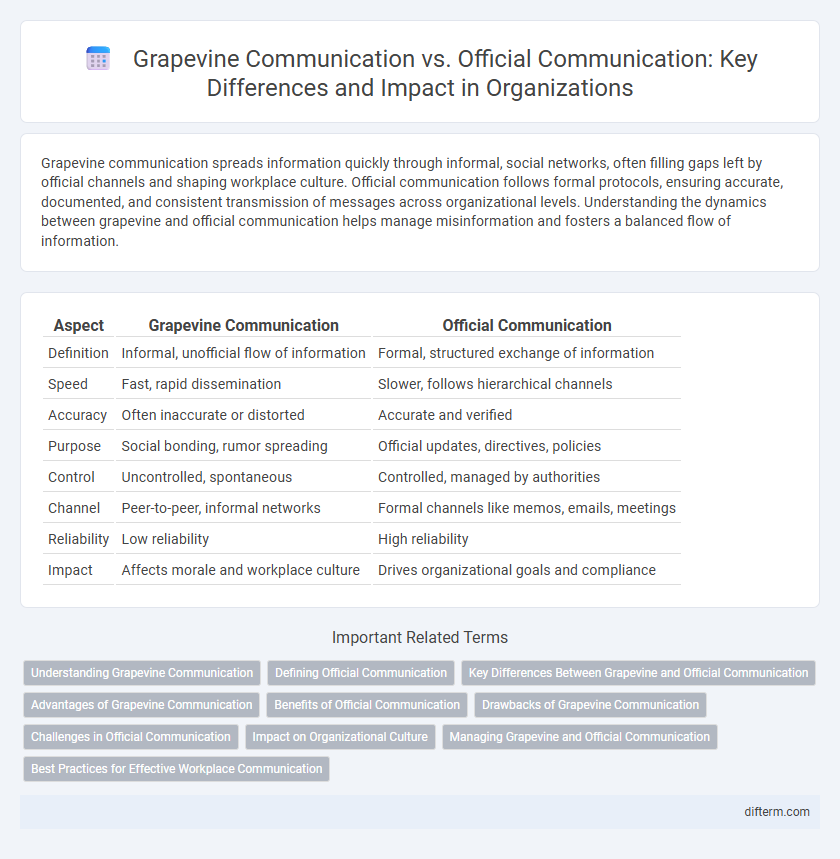Grapevine communication spreads information quickly through informal, social networks, often filling gaps left by official channels and shaping workplace culture. Official communication follows formal protocols, ensuring accurate, documented, and consistent transmission of messages across organizational levels. Understanding the dynamics between grapevine and official communication helps manage misinformation and fosters a balanced flow of information.
Table of Comparison
| Aspect | Grapevine Communication | Official Communication |
|---|---|---|
| Definition | Informal, unofficial flow of information | Formal, structured exchange of information |
| Speed | Fast, rapid dissemination | Slower, follows hierarchical channels |
| Accuracy | Often inaccurate or distorted | Accurate and verified |
| Purpose | Social bonding, rumor spreading | Official updates, directives, policies |
| Control | Uncontrolled, spontaneous | Controlled, managed by authorities |
| Channel | Peer-to-peer, informal networks | Formal channels like memos, emails, meetings |
| Reliability | Low reliability | High reliability |
| Impact | Affects morale and workplace culture | Drives organizational goals and compliance |
Understanding Grapevine Communication
Grapevine communication is an informal network where information spreads rapidly and often unofficially among employees, bypassing formal channels. Understanding the nuances of grapevine communication helps organizations identify underlying employee sentiments, rumors, and real-time concerns that official communication may overlook. Effective management of grapevine communication enhances workplace transparency and improves overall organizational communication dynamics.
Defining Official Communication
Official communication refers to the structured and formal exchange of information within an organization, following predefined channels and protocols. It ensures clarity, accuracy, and accountability by documenting messages through emails, memos, reports, and meetings sanctioned by management. This type of communication supports organizational goals by providing consistent and reliable information to employees, stakeholders, and external partners.
Key Differences Between Grapevine and Official Communication
Grapevine communication operates informally and spreads through social interactions without structured channels, often resulting in faster but less reliable information flow. Official communication follows formal pathways established by organizational hierarchy, ensuring accuracy, accountability, and documentation. Unlike grapevine communication, official communication is typically documented, authorized, and designed to maintain organizational coherence and control.
Advantages of Grapevine Communication
Grapevine communication fosters faster information flow across all organizational levels, enabling employees to receive updates more quickly than through official channels. It enhances social bonds and trust among team members by promoting informal interactions and candid feedback. This method often uncovers underlying employee sentiments and workplace issues that formal communication might overlook, improving overall organizational awareness.
Benefits of Official Communication
Official communication ensures clarity, consistency, and accountability in information dissemination within organizations, reducing misunderstandings and misinformation common in grapevine channels. It facilitates structured feedback mechanisms and maintains formal records, supporting decision-making and compliance with organizational policies. Reliable official communication enhances trust among stakeholders by providing verified and authoritative messages.
Drawbacks of Grapevine Communication
Grapevine communication often leads to misinformation due to its informal nature and lack of verification, causing confusion and misunderstandings among employees. It bypasses official channels, resulting in a lack of accountability and inconsistent message delivery. The informal spread of rumors through grapevine communication can damage workplace morale and trust within the organization.
Challenges in Official Communication
Official communication often faces challenges such as delays due to hierarchical approval processes, which impede the swift dissemination of information. Strict adherence to formal language and protocols can result in misunderstandings or lack of clarity, reducing message effectiveness. Additionally, the rigidity of official communication channels limits feedback opportunities, causing decreased employee engagement and collaboration.
Impact on Organizational Culture
Grapevine communication fosters a dynamic organizational culture by enabling informal information flow that quickly spreads employee sentiments and unfiltered feedback. Official communication, characterized by structured and formal channels, reinforces organizational values and ensures consistency in message delivery, strengthening cultural alignment. Both communication types impact trust and engagement, with grapevine communication enhancing social bonds while official communication upholds clarity and authority.
Managing Grapevine and Official Communication
Managing grapevine communication requires monitoring informal channels to identify rumors and misinformation while promoting transparency to maintain trust within the organization. Official communication involves structured messages delivered through formal channels such as memos, emails, and meetings, ensuring clarity, consistency, and accountability. Balancing both communication types enhances organizational effectiveness by addressing employee concerns informally while reinforcing official policies and updates.
Best Practices for Effective Workplace Communication
Grapevine communication, often informal and rapid, complements official communication channels by facilitating quick information flow and employee engagement. Best practices for effective workplace communication include validating information received through grapevine channels to prevent misinformation and maintaining transparency through consistent, clear official communication. Encouraging open dialogue and feedback ensures alignment between informal and formal messaging, enhancing overall organizational trust and collaboration.
grapevine communication vs official communication Infographic

 difterm.com
difterm.com